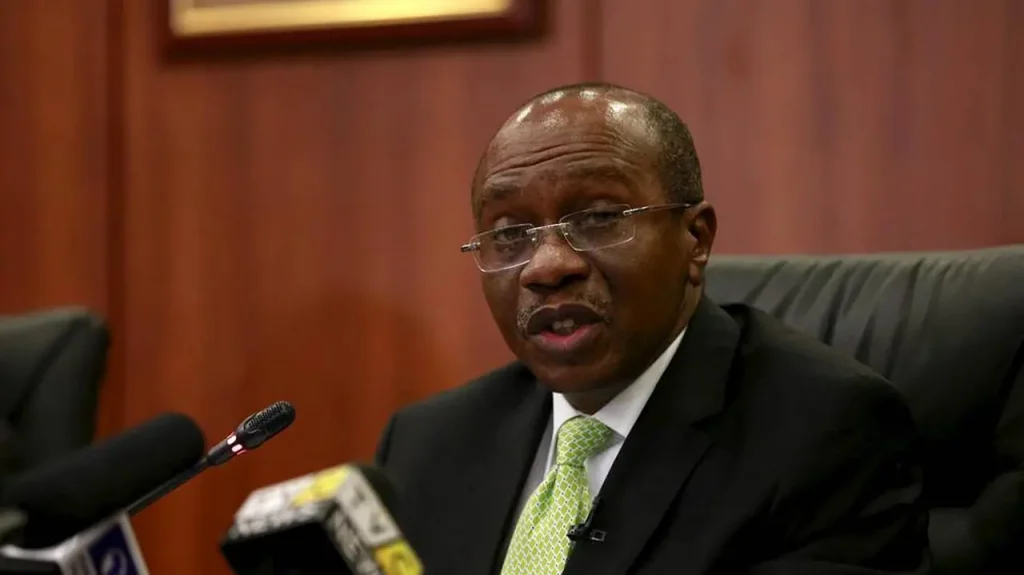- Nigeria’s central bank raised the benchmark interest rate by 150 base points to 13 per cent
- Six members of the MPC voted in favour of an increase in the key lending rate by 150 basis points, four members voted in favour of an increase of 100 basis points, and one member voted in favour of an increase of 50 basis points
- Nigeria’s longest 30-year bond increased by 75 basis points to 13.8 per cent. While overnight lending rates increased by 200 basis points to reach 14%, the key share index (.NGSEINDEX) dropped to a level that was the lowest in two weeks
To battle growing inflation, Nigeria’s central bank raised the benchmark interest rate to 13 per cent which translates to 150 basis points Tuesday, the first increase in more than two years, sending markets plummeting.
Analysts and traders expected the Monetary Policy Committee (MPC) to maintain the current rate.
On Tuesday, May 24, 2022, the Governor of the Central Bank of Nigeria, Godwin Emefiele, released this information while reading the communiqué of the third monetary policy committee meeting of the year.
The Central Bank governor, who renounced his presidential bid on Monday, predicted that the economy would expand by 3.25 per cent this year, below the federal government’s forecast of 4.2% growth.
Six members of the MPC voted in favour of an increase in the key lending rate by 150 basis points, four members voted in favour of an increase of 100 basis points, and one member voted in favour of an increase of 50 basis points.
It was the most significant increase in interest rates since the Federal Reserve raised them by 200 basis points in July 2016.
The Central Bank of Nigeria is taking a more hawkish stance in order to slow the rate of inflation that has been steadily climbing in the country while simultaneously ensuring the growth of the economy. The Central Bank of Nigeria (CBN) previously held the position that increasing interest rates would not have a beneficial effect on inflation.
“MPC also feels that tightening would not only reverse the steady improvement recorded in credit expansion, but It is also of the opinion that tightening would not always bring inflation under control, particularly when the marginal fall is not yet sustainable.
“The committee agreed to raise the monetary policy rate for the first time in over two and a half years in order to put a stop to the current rise in inflation. Members of the committee (MPC) were of the opinion that the continuing upswing may have a negative impact on growth.”
Prices of food and energy are going up in the country with the most people on the African continent as a result of Russia’s invasion of Ukraine, which drove up the price of oil and disrupted supplies of basic commodities like wheat and corn.
As a result of the interest rate increase, the yield on Nigeria’s longest 30-year bond increased by 75 basis points to 13.8 per cent. While overnight lending rates increased by 200 basis points to reach 14%, the key share index (.NGSEINDEX) dropped to a level that was the lowest in two weeks.
Six members of the MPC voted in favour of an increase in the key lending rate by 150 basis points
History of Rate Variations
The recent Nigeria’s central bank rise of benchmark interest was the first one implemented by the monetary policy council of the central bank since July of 2016. Prior to that time, the apex bank favoured lower interest rates in the hope that it would encourage lending.
To counteract the persistently increasing cost of goods and services, however, the world’s most influential central bank has followed the pattern of other central banks throughout the world and raised interest rates.
Pundits are led to assume that the policies of the CBN have little to no influence since, unlike in other economies across the world, the rising inflation in Nigeria is driven more by supply than by demand.
The previous time the central bank of Nigeria increased interest rates was in July 2016, when they increased from 12% to 14% and lasted at that level until March 2019, when they decreased to 13.5%, signifying the CBN’s plan to halt its profitable OMO sales.
Meanwhile, interest rates have fallen to 12.5 per cent in response to Covid-19 in May 2020, and on September 11.5 per cent, where it has remained until the most recent modification of rates.
Is the CBN Trying to communicate something?
The shift in interest rates indicates that the central bank has now accepted inflation’s influence on the monetary policies it implements. Prior to this, it has favoured a strategy that compels the government to look into addressing supply chain bottlenecks while believing that lower interest rates may help spur lending and, as a result, increase economic growth. Currently, however, this is no longer the preferred approach.
According to Razia Khan, head economist for Africa and the Middle East at Standard Chartered, the recent hike in rates has prompted doubts about whether or not this could be a precursor to a change in the central bank’s stance towards foreign exchange.
She noted that “this could be the most important indication yet of ultimate FX policy goals,” but that “we will not know” until we see whether and how much market rates reprice.
Read: Nigeria’s Central bank crackdown on Fintech firms to hinder investment
